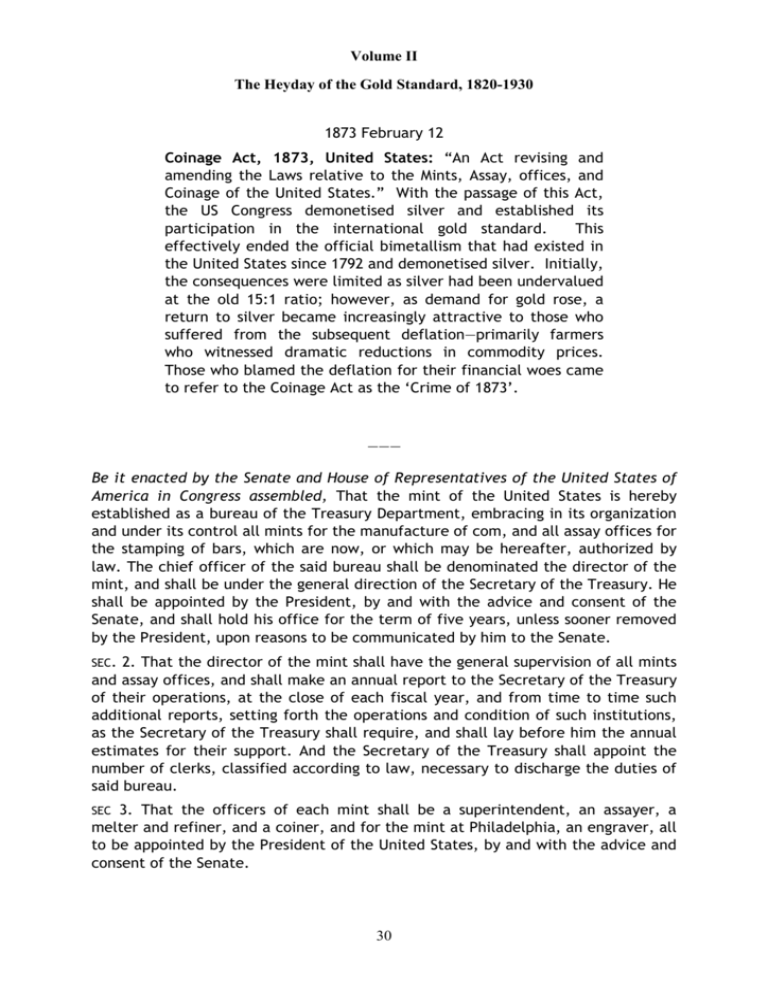

- #Coinage act of 1873 purpose full
- #Coinage act of 1873 purpose plus
- #Coinage act of 1873 purpose free
#Coinage act of 1873 purpose plus
The "standard weight" is the total weight of the coin (pure metal plus alloy). The "standard fineness" is the percentage of the coin's weight consisting of the pure metal, the remainder being essentiallyĪ worthless alloy. The "fine weight" of a coin is the amount of the pure metal (either gold or silver) that it contains.
#Coinage act of 1873 purpose free
However, free coinage for silver coins less than a dollar ended in 1853, and the Act of 1873 ended free coinage of the standard silver dollar. The Freedom of Coinage, 1792 –1873 table shows that free coinage for gold was always available from 1792 to 1873 (and in fact until the United States abandoned the gold standard in 1933). 708.Ī third element of a coin standard is that there be "free coinage," meaning that any private party may bring gold or silver in large quantities to the mint to be coined, and receive the coin or money equivalent. 215).ĭCoins less than standard weight and limit of tolerance at valuation proportional to their actual weights.ĮLeading to 1874, 43-3586, Rev.
#Coinage act of 1873 purpose full
Trade-dollar c, half-dollar, quarter-dollar, dimeīCoins less that full weight at values proportional to their actual weights.ĬLegal tender eliminated in 1876 (J.R. Half-dollar, quarter dollar, dime, half dime Legal-Tender Power of Gold and Silver Coin, 1792 –1875 While The Coinage Act of 1873 essentially did not address this issue, a revised statute the next year also limited the standard silver dollar to a value of five dollars as legal tender. Legal-Tender Power of Gold and Silver Coin, 1792 –1875 table shows that from 1792 to 1875, gold coins could satisfy unlimited financial obligation (had "unlimited legal-tender power") whereas after 1853, silver coins other than a silver dollar could only satisfy obligations up to five dollars (possessed only "limited legal-tender power"). 47).Ī second important consideration is that the coins issued must be accepted and satisfy the owner's monetary obligations, whatever the amount.

485).įIntended for use only in international transactions. Authority for Gold and Silver Coinage, 1792 –1875ĭollar a, half-dollar, quarter dollar, dime, half dime aĬRenamed one-dollar piece in Coinage Act of 1873.ĭDiscontinued by Act of 1890 (P.L. Second, the Act of 1873 eliminated three existing coins made of silver, of which the silver dollar was the most important, and created a "trade-dollar," a special silver dollar coin to be used in international trade. As gold was (and still is) much more valuable per ounce than silver, a silver coin worth more than one dollar would have been too large for practical use, and a gold coin worth less than a dollar would have been too small. First, the least valuable gold coin was worth one dollar, and the most valuable silver coin also was worth one dollar. The Authority for Gold and Silver Coinage, 1792 –1875 table details laws that authorized U.S. LEGISLATIVE HISTORY OF GOLD AND SILVER COINSįor a country to be considered to be on metallic standard, whether gold, silver, or bimetallic -using both gold and silver -the first principle is that its mint must issue coins. The act has a legislative history that dates to the Coinage Act of 1792, and it led eventually to the enactment of the Gold Standard Act of 1900. The important sections of the act of 1873 concerned gold and silver coinage, the basis of the monetary standard of the United States at the time. 424) comprehensively revised and rewrote the existing laws regarding mint and coinage issues.


 0 kommentar(er)
0 kommentar(er)
